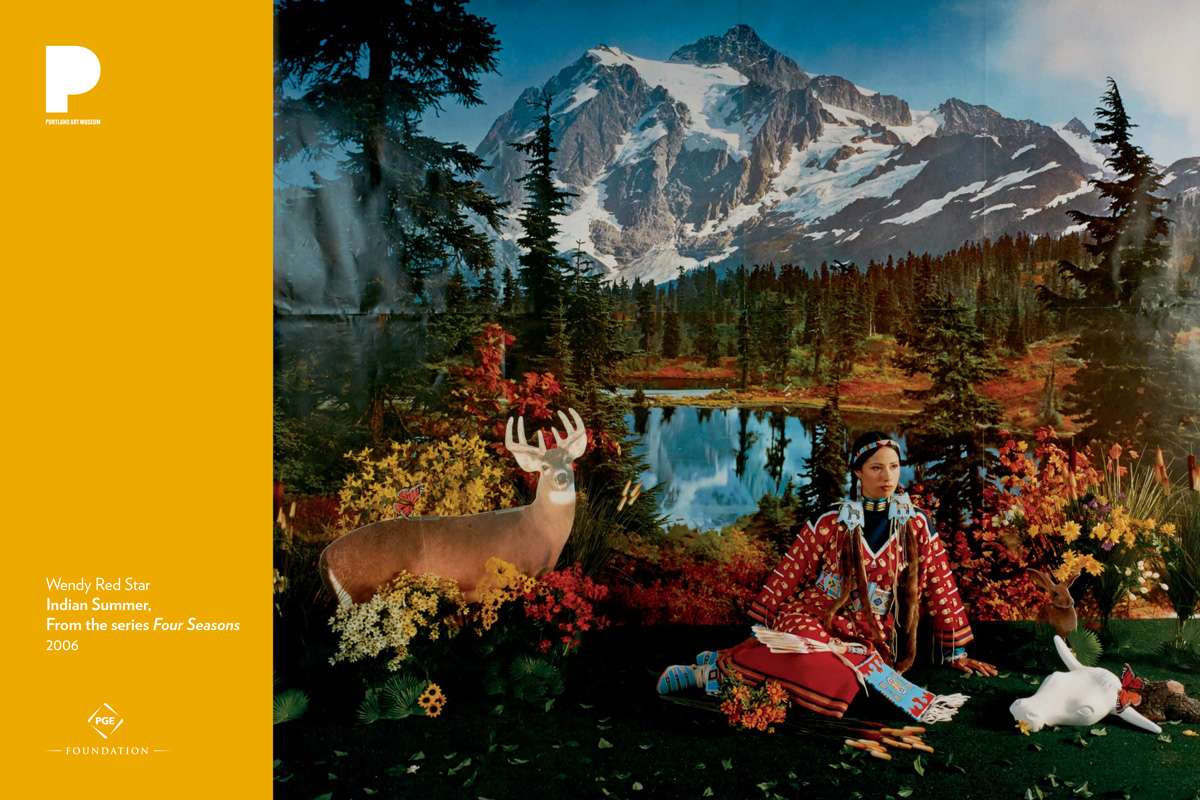
Artist Wendy Red Star works across disciplines to explore the intersections of Native American ideologies and colonialist structures, both historically and in contemporary society. Raised on the Apsa’alooke (Crow) reservation in Montana, Red Star’s work is informed both by her cultural heritage and her engagement with many forms of creative expression, including photography, sculpture, video, fiber arts, and performance. An avid researcher of archives and historical narratives, Red Star seeks to incorporate and recast her research, offering new and unexpected perspectives in work that is at once inquisitive, witty, and unsettling. Intergenerational collaborative work is integral to her practice—her daughter Beatrice Red Star Fletcher (now 10 years old) often collaborates with her. Red Star is committed to creating a forum for the expression of Native women’s voices in contemporary art.
The Four Seasons series of photographs depicts Red Star, wearing a traditional elk-tooth dress, surrounded by dioramas made of cheap plastic backdrops, blow-up animals, plastic flowers, and AstroTurf. This mixing of high and low craftsmanship encourages humor and irony. The scene evokes and mocks the dioramas sometimes seen in natural history museums, where Native American figures appear frozen in the distant past alongside taxidermic animals. Red Star uses the mass-produced materials to challenge dominant perceptions of Indigenous cultures and art: “There’s a whole notion of being ‘authentic,’” Red Star says. “Your art is supposed to look like the nineteenth century, like we’re a dead culture that never evolved.”
For Red Star, humor is one of the most effective tools to challenge stereotypes of Native Americans as “primitive” or “closer to nature” than the supposedly more civilized white population. Red Star explains, “I’m dealing with really heavy topics pertaining to Crow and Native culture and the colonization of people. You can be very heavy handed about it, but people don’t want to be around that. You can find an in by using humor. Humor or wit can be very healing, by getting viewers to crack a smile or laugh I can get them in, that way they can investigate my work further.”
Red Star often includes herself as a subject in her photographs, in part, to counteract the history of white photographers representing Native people and to assert control over her own image. She says, “People are always telling us what we should be or how we should look or how authentic we should be. It’s empowering for me to put my own imagery out there [and show] my perspective for a change.”
Wendy Red Star lives and works in Portland, Oregon.
Discussion and activities
- The title of this work in the Four Seasons series is Indian Summer. What does the phrase “Indian summer” mean? Why do you think Red Star chose it as the title? How does the title contribute to her project of using humor and irony to challenge stereotypes?
- Look closely at the image. List all of the objects and materials that you can identify. What details did you first notice that told you the props and the scene were artificial?
- Although the setting and props are made from artificial, mass-produced materials, Red Star’s clothes and beadwork were created for her by friends and family. Traditional Apsa’alooke elk-tooth dresses, for example, symbolize wealth and honor and are worn on special occasions. Lance Hogan made this dress for Red Star in 1997 when she was a princess at the annual Crow Fair. Why do you think Red Star chose to include these personal items in Indian Summer? How do these elements contribute to the piece as a meditation on identity?
- Compare Wendy Red Star’s Indian Summer (2006) to Charles Heaney’s painting Mountains (1938), also included in the Poster Project. These artists have each chosen to depict western United States mountain scenes—yet with very different materials and intentions—75 years apart. If these artworks could have a conversation, what do you think they would say to each other?
Recommended online resources
- Wendy Red Star
- Wendy Red Star: Apsáalooke Feminist
- Wendy Red Star – Contemporary Native Photographers and the Edward Curtis Legacy
- Artist Talk: Wendy Red Star
- Object Stories: Dolls that Teach Generations Culture
- Abaki Beck, “Decolonizing Photography: A Conversation with Wendy Red Star,” Aperture (December 14, 2016)
- Zach Dundas, “Wendy Red Star Totally Conquers the Wild Frontier” Portland Monthly (April 2, 2015)
- Wendy Red Star and Dr. Steven Zucker, “Wendy Red Star, 1880 Crow Peace Delegation,” in Smarthistory, March 21, 2018, accessed May 23, 2018.
Spanish-language PDFs developed with the support and collaboration of
